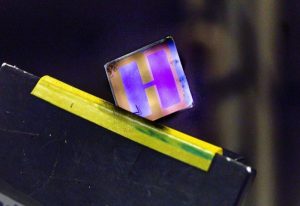
Swedish and Chinese scientists have developed organic solar cells optimised to convert ambient indoor light to electricity. The power they produce is low, but is probably enough to feed the millions of products that the internet of things will bring online. For more information see the IDTechEx report on Energy Harvesting Microwatt to Megawatt 2019-2029.
As the internet of things expands, it is expected that we will need to have millions of products online, both in public spaces and in homes. Many of these will be the multitude of sensors to detect and measure moisture, particle concentrations, temperature and other parameters. For this reason, the demand for small and cheap sources of renewable energy is increasing rapidly, in order to reduce the need for frequent and expensive battery replacements.
This is where organic solar cells come in. Not only are they flexible, cheap to manufacture and suitable for manufacture as large surfaces in a printing press, they have one further advantage: the light-absorbing layer consists of a mixture of donor and acceptor materials, which gives considerable flexibility in tuning the solar cells such that they are optimised for different spectra – for light of different wavelengths.
Researchers in Beijing, China, led by Jianhui Hou, and Linköping, Sweden, led by Feng Gao, have now together developed a new combination of donor and acceptor materials, with a carefully determined composition, to be used as the active layer in an organic solar cell. The combination absorbs exactly the wavelengths of light that surround us in our living rooms, at the library and in the supermarket.
The researchers describe two variants of an organic solar cell in an article in Nature Energy, where one variant has an area of 1 cm2 and the other 4 cm2. The smaller solar cell was exposed to ambient light at an intensity of 1000 lux, and the researchers observed that as much as 26.1% of the energy of the light was converted to electricity. The organic solar cell delivered a high voltage of above 1 V for more than 1000 hours in ambient light that varied between 200 and 1000 lux. The larger solar cell still maintained an energy efficiency of 23%.
“This work indicates great promise for organic solar cells to be widely used in our daily life for powering the internet of things,” says Feng Gao, senior lecturer in the Division of Biomolecular and Organic Electronics at Linköping University.
“We are confident that the efficiency of organic solar cells will be further improved for ambient light applications in coming years, because there is still a large room for optimization of the materials used in this work,” Jianhui Hou, professor at the Institute of Chemistry, Chinese Academy of Sciences, underlines.
The result is a further advance in research within the field of organic solar cells. In the summer of 2018, for example, the scientists, together with colleagues from a number of other universities, published rules for the construction of efficient organic solar cells (see the link given below). The article collected 25 researchers from seven universities, and was published in Nature Materials. The research was led by Feng Gao. These rules have proven to be useful along the complete pathway to efficient solar cell for indoor use.
